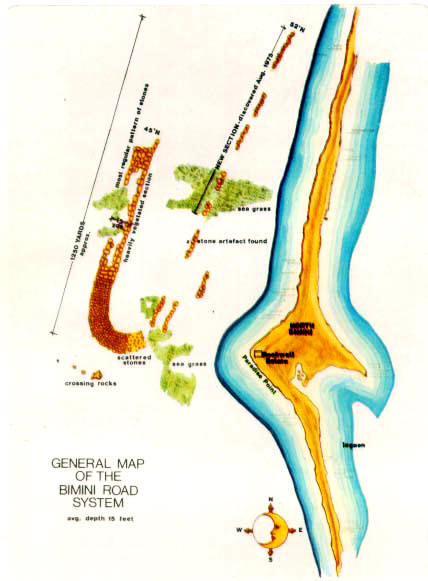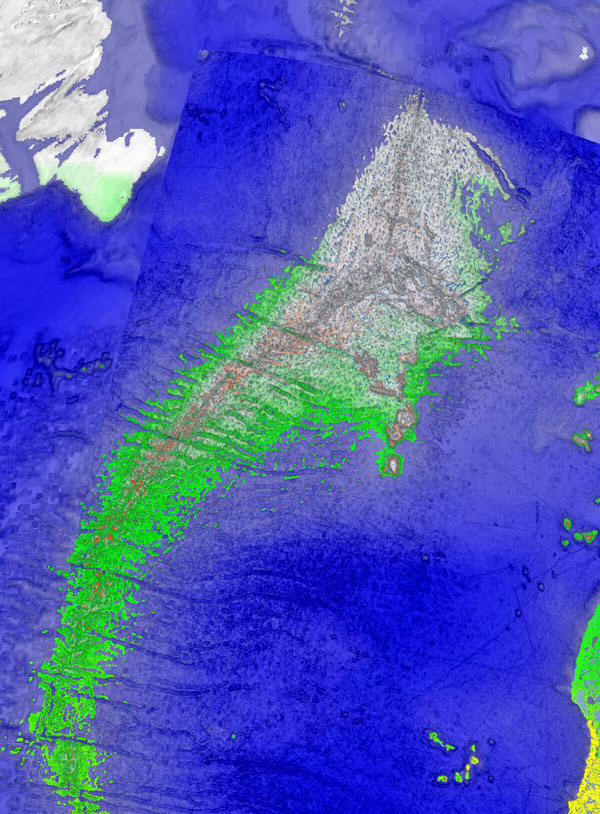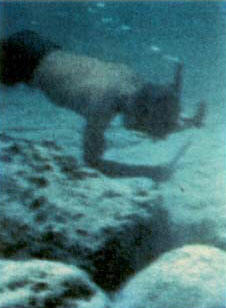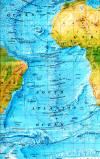|
The question of Atlantis was reopened.
Could this be Poseidia, described by Cayce as the 'western' section of
Atlantis? Were Plato and the other Atlantists right after all when they
placed their lost civilization way out in the Atlantic Ocean?
Their discovery was immediately hailed by some as
the fulfillment of a 28 year-old prophecy concerning the reappearance of Atlantis. Indeed one of the pilots had been keeping a lookout for underwater
structures while flying his regular assignments because he believed Atlantis
was about to reemerge from the Atlantic in this very area.
Between 1923 and 1944 Cayce made numerous references to Atlantis in the course of trance interviews concerning the alleged former lives of the people who consulted him. These interviews were recorded verbatim, and much of the material about Atlantis has been published in a book called Edgar Cayce on Atlantis, by Cayce's son Edgar Cayce. It includes this prediction, made in June 1940:
According to the Cayce readings, Poseidia was the "western section of Atlantis," and the area off Bimini is the highest point of this sunken land.
So the
A.R.E. is naturally delighted about the underwater find in the
Bahamas, just where and when the famous prophet said something would appear.
Until this and similar discoveries have been thoroughly explored, we have to
admit that There may yet have an equally plausible rival for the title of
Atlantis, right where most people always considered the long-lost continent
to be - in the Atlantic.
Not everyone accepts these underwater features as being of man-made origin. The so-called "Bimini road" is dismissed by skeptics as nothing more than beach rock that just happens to have produced an unusual effect. Berlitz and Dr. Manson Valentine, the American archaeologist and oceanographer who discovered the "road", do not agree.
Other sightings made off Bimini, at distances up to 100 miles from the shore, include what appear to be vertical walls, a great arch, and pyramids or bases for pyramids under the sea. some 10 miles north of Andros, another island in the Bahamas, pilots have photographed formations on the seabed that look like great circles of standing stones, reminiscent of Stonehenge.
Off the coasts of eastern Yucatan and British Honduras seemingly man-made
roads stretch far out to sea, and off Venezuela a 100-mile 'wall' runs along
the ocean bottom. However, geologists have declared many of these to be
natural features, and deem the Venezuelan wall "too big to be considered
man-made". According to Berlitz, the Russians have explored an underwater
building complex covering over 10 acres of the sea floor north of Cuba, and
the French bathyscape Archimede has reported sighting flights of steps
carved in the steep continental shelf off northern Puerto Rico.
When a computer was used to reassemble the continental jigsaw, the fit across the Atlantic was found, with some adjustment, to be fairly satisfactory. But that picture does not take account of a fascinating underwater feature known as the mid-Atlantic Ridge.
This mountainous ridge, nearly two miles high and hundreds of miles wide, runs in an S-curve down the Atlantic midway between the Americas and Africa and Europe, following the contours of those continents and marking its course above water with a number of islands, such as the Azores, Ascension Island, and Tristan da Cunha.
As early as 1883 Ignatius Donnelly suggested that the mid-Atlantic Ridge was a remnant of Atlantis. But most modern geologists and oceanographers consider that, far from being the relic of a continent that sank beneath the sea, the ridge was forced upward from the ocean floor, probably by volcanic activity.
One theory is that as the continents drifted apart they produce a huge fault line that is a center of earthquake and produce a huge fault line that is a center of earthquake and volcanic action. Some of the earth's molten center has erupted through this crack and built up into a ridge, even rising above the waves in several places. However, there is evidence that this explanation may have to reviewed before too long.
Seabed cores taken from the mid-Atlantic Ridge in 1957 brought up freshwater plants from a depth of two miles. And in one of the deep valleys, known as Romanche, sands have been found that appear to have been formed by weathering when that part of the ridge was above water level.
In a 1969 a Duke University research expedition dredged 50 sites along an underwater ridge running from Venezuela to the Virgin Islands, and brought up granitic rocks, which are normally found only on continents. Commenting on this discovery, Dr. Bruce Heezen of the Lamont Geological Observatory said:
A recent report on the nature of the Atlantic seabed appears to confirm that there is at least part of a former continent lying beneath the ocean. Under the heading "Concrete Evidence for Atlantis?" the British Journal New Scientist of June 5, 1975 reported,
The report goes on to state that in 1971 two researchers from the University of Miami recovered some shallow-water limestone fragments from deep water in the area. Minerals in the limestone indicated that they came from a nearby source of granite that was unlikely to occur on the ocean floor.
More
exhaustive analysis of the dredge samples revealed that the limestones
included traces of shallow-water fossils, implying formation in very shallow
water indeed, a view confirmed by the ratios of oxygen and carbon isotopes
found in the fragments. One piece of limestone was pitted and showed
evidence of tidal action.
Atlantists reply that Dr. Ewing could have been looking in the wrong places, or perhaps too close to the center of the destructive forces that plunged Atlantis into the ocean. Some Atlantists have suggested that the original Atlantic landmass broke up into a least two parts, one of which sank long after the other. Perhaps Plato's Atlantis was a remnant of the continent that oceanographers now appear to have detected in the Atlantic, and perhaps it was not submerged until very much more recent times.
The bed of the
Atlantic is, after all, an unstable are and one that has given birth to
numerous islands, then swallowed them up again. In 1811, for example,
volcanic activity in the Azores resulted in the emergence of a new island
called Sammrina, which shortly sank back again into the sea. In our own
time, the island of Surtsey, 20 miles southwest of Iceland, has slowly risen
from the ocean. Surtsey was formed during a continuous underwater eruption
between 1963 and 1966.
On the other hand, there are some Atlantists who believe that the
destruction of Atlantis was brought about not by geological events but by a
man-made disaster, such as a nuclear explosion. According to the
Cayce
readings, the Atlanteans achieved an astonishingly high level of technology
before the continent sank, around 10,000 B.C. They invented the laser,
aircraft, television, death rays, atomic energy, and cybernetic control of
human beings, and it was the misuse of the tremendously powerful natural
forces they had developed that caused their destruction.
This work alone would appear to justify the description of Cayce as America's most talented psychic. And if one aspect of his clairvoyant powers could prove so successful, it seems reasonable to give a fair hearing to other psychic statements he made, however, fantastic.
Cayce's sons, who help run the organization set up to study his work, admit that their life would be far simpler if Edgar Cayce had never mentioned Atlantis. Hugh Lynn Cayce comments:
Edgar Evans Cayce makes the comment that,
If, as his sons and thousands of followers believe, Edgar Cayce's readings were supernormal and not the product of reading the works of others, it is certainly an intriguing case. There are, for example, some fascinating similarities between Cayce's descriptions of Atlantis and those of occultists such as Madame Blavatsky, Rudolf Steiner, and W. Scott-Elliott, including references to the Atlanteans telepathic and other supernormal powers, their advanced technology, their moral disintegration, and the civil strife and misuse of their powers that finally caused their demise.
Cayce's
readings also mention
Lemuria, or Mu. Either
Cayce was psychically readings
the works of these earlier writers, or he - the they - really were 'tuning
in' to the past.
Is it the thrill of the
search - the hope of finding a master key to unlock the secrets of the past?
Or is it simply man's thirst for mystery itself - for something grand and
inexplicable, larger than himself? Certainly popular interest in the
mystical side of Atlantis is always most intense when the life of the spirit
is in the greatest disarray - during the latter half of the 19th Century, in
the aftermath of Darwin's bombshell, for example, and during our own time.
Atlantis has intrigued and inspired people for a very
long time. Perhaps, for the time being, we should be glad that the answer
has not yet been found, and that Plato's lost continent remains just beyond
our grasp.
|




